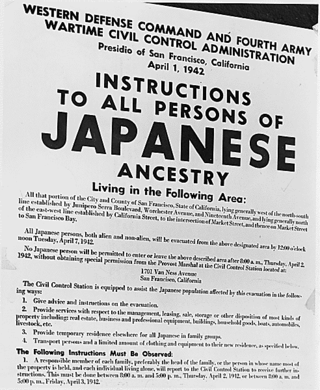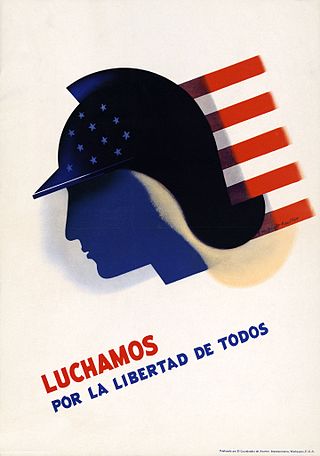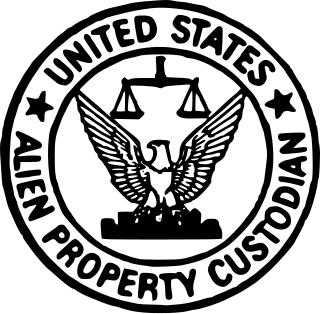
Executive Order 9066 was a United States presidential executive order signed and issued during World War II by United States president Franklin D. Roosevelt on February 19, 1942. "This order authorized the forced removal of all persons deemed a threat to national security from the West Coast to "relocation centers" further inland—resulting in the incarceration of Japanese Americans." Two-thirds of the 125,000 people displaced were U.S. citizens.

The Executive Office of the President of the United States (EOP) comprises the offices and agencies that support the work of the president at the center of the executive branch of the United States federal government. The office consists of several offices and agencies, such as the White House Office, the National Security Council, and the Office of Management and Budget.

The Farm Credit Administration is an independent agency of the federal government of the United States. Its function is to regulate the financial institutions that provide credit to farmers.

In the United States, an executive order is a directive by the president of the United States that manages operations of the federal government. The legal or constitutional basis for executive orders has multiple sources. Article Two of the United States Constitution gives presidents broad executive and enforcement authority to use their discretion to determine how to enforce the law or to otherwise manage the resources and staff of the executive branch. The ability to make such orders is also based on expressed or implied Acts of Congress that delegate to the president some degree of discretionary power. The vast majority of executive orders are proposed by federal agencies before being issued by the president.

The Rural Electrification Act of 1936, enacted on May 20, 1936, provided federal loans for the installation of electrical distribution systems to serve isolated rural areas of the United States.

The Office of the Coordinator of Inter-American Affairs, later known as the Office for Inter-American Affairs, was a United States agency promoting inter-American cooperation (Pan-Americanism) during the 1940s, especially in commercial and economic areas. It was started in August 1940 as OCCCRBAR with Nelson Rockefeller as its head, appointed by President Franklin Delano Roosevelt.

The Office of Censorship was an emergency wartime agency set up by the United States federal government on December 19, 1941, to aid in the censorship of all communications coming into and going out of the United States, including its territories and the Philippines. The efforts of the Office of Censorship to balance the protection of sensitive war related information with the constitutional freedoms of the press is considered largely successful.

The Office of Alien Property Custodian was an office within the government of the United States during World War I and again during World War II, serving as a custodian to property that belonged to US enemies. The office was created in 1917 by Executive Order 2729-A under the Trading with the Enemy Act of 1917 (TWEA) in order to "assume control and dispose of enemy-owned property in the United States and its possessions."
The Office of War Mobilization (OWM) was an independent agency of the United States government formed during World War II to coordinate all government agencies involved in the war effort. It was formed on May 27, 1943, by Executive Order 9347.

The Office of Civil Defense (OCD) was an agency of the United States Department of Defense from 1961–64. It replaced the Office of Civil and Defense Mobilization. The organization was renamed the Defense Civil Preparedness Agency on May 5, 1972, and was abolished on July 20, 1979, pursuant to Executive Order 12148. Its duties were given to the Federal Emergency Management Agency (FEMA).

Office of Civilian Defense was a United States federal emergency war agency set up May 20, 1941, by Executive Order 8757 to co-ordinate state and federal measures for protection of civilians in case of war emergency. Its two branches supervised protective functions such as blackouts and special fire protection and "war service" functions such as child care, health, housing, and transportation. It also created the Civil Air Patrol. The agency was terminated by Executive Order 9562 of June 4, 1945. The Office of Civil Defense with similar duties was established later.

The Non-Detention Act of 1971 is a United States statute enacted to repeal portions of the McCarran Internal Security Act of 1950, specifically Title II, the "Emergency Detention Act". The law repealed the Emergency Detention Act of 1950 provisioning the United States Attorney General with powers for detention of anyone in the US deemed to be a threat to the national security of the United States. The 64 Stat. 1019 statute was codified within Title 50 War and National Defense as 50 U.S.C. ch. 23, subch. II §§ 811-826.

The Office of Economic Stabilization was established within the United States Office for Emergency Management on October 3, 1942, pursuant to the Stabilization Act of 1942, as a means to control inflation during World War II through regulations on price, wage, and salary increases.

The Reorganization Act of 1939, Pub. L.Tooltip Public Law 76–19, 53 Stat. 561, enacted April 3, 1939, is an American Act of Congress which gave the President of the United States the authority to hire additional confidential staff and reorganize the executive branch for two years subject to legislative veto. It was the first major, planned reorganization of the executive branch of the government of the United States since 1787. The Act led to Reorganization Plan No. 1, which created the Executive Office of the President.
The Federal Works Agency (FWA) was an independent agency of the federal government of the United States which administered a number of public construction, building maintenance, and public works relief functions and laws from 1939 to 1949. Along with the Federal Security Agency and Federal Loan Agency, it was one of three catch-all agencies of the federal government pursuant to reorganization plans authorized by the Reorganization Act of 1939, the first major, planned reorganization of the executive branch of the government of the United States since 1787.

The Stabilization Act of 1942, formally entitled "An Act to Amend the Emergency Price Control Act of 1942, to Aid in Preventing Inflation, and for Other Purposes," and sometimes referred to as the "Inflation Control Act", was an act of Congress that amended the Emergency Price Control Act of 1942.

The Emergency Price Control Act of 1942 is a United States statute imposing an economic intervention as restrictive measures to control inflationary spiraling and pricing elasticity of goods and services while providing economic efficiency to support the United States national defense and security. The Act of Congress established the Office of Price Administration (OPA) as a federal independent agency being officially created by Franklin D. Roosevelt on April 11, 1941.
Presidential reorganization authority is a term used to refer to a major statutory power that has sometimes been temporarily extended by the United States Congress to the President of the United States. It permits the president to divide, consolidate, abolish, or create agencies of the U.S. federal government by presidential directive, subject to limited legislative oversight. First granted in 1932, presidential reorganization authority has been extended to nine presidents on 16 separate occasions. As of 2017, it was most recently granted to Ronald Reagan.

Air Raid Attack Act of 1942 was a United States federal statute authorizing the United States civil defense to protect Americans and property from bombing attacks, sabotage, and war hazards upon the United States entry into World War II. The Act of Congress established Civilian Defense regulations prohibiting the obstruction of the duties and rights of local districts, municipals, counties, and State officials.

Passport Act of 1920 or Passport Control Act, 1920 was a federal statute authored by the United States 66th Congress. The legislation was an appropriations bill authorizing a fiscal policy for the United States Diplomatic and Consular Service.









